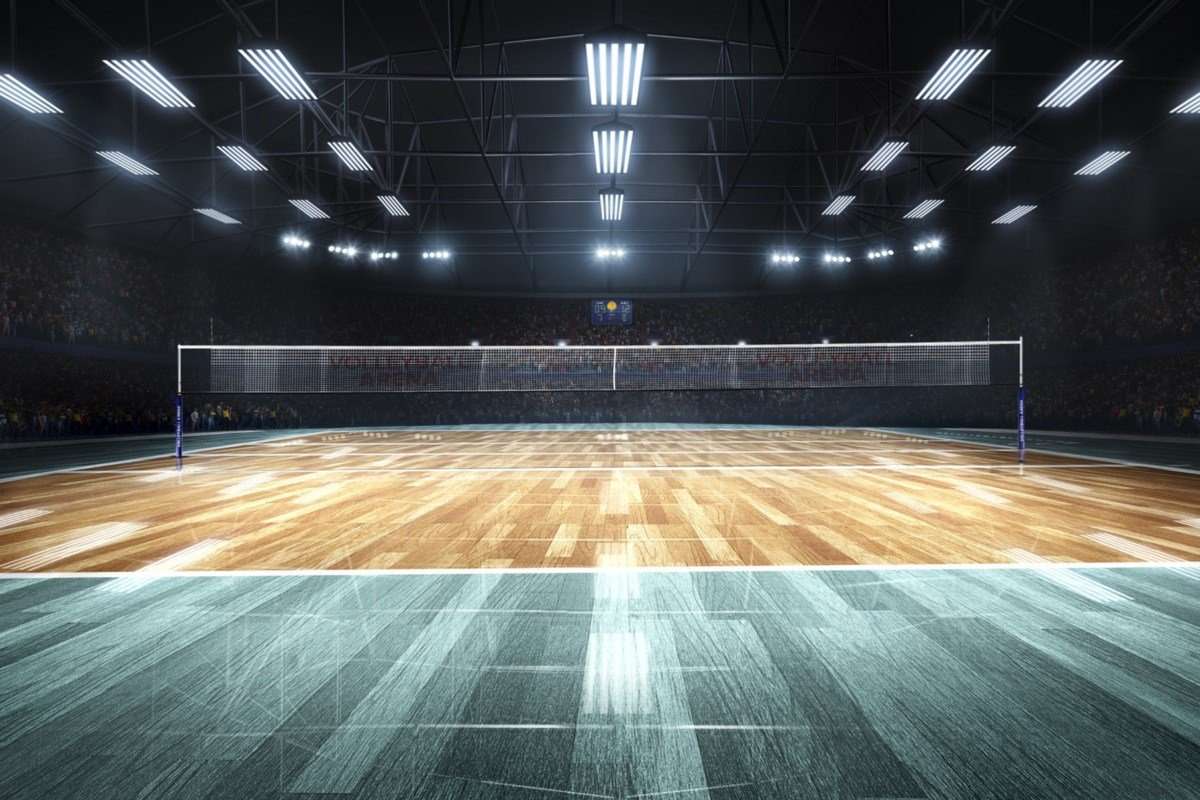Contents
- Volleyball courts: size, layout and game structure
- Historical Brief
- Game Rules
- Basic Rules
- Positioning
- Serving
- Points
- Playground
- Sizes and Features
- Playground Layout
- Inventory Item Requirements
- Net
- Ball
- Judges

Volleyball playgrounds: dimensions, layout and structure of the game
Volleyball is a team sport included in the program of the Summer Olympic Games. During the match, players must guide the ball over the net in such a way that it ends up on the opponent's side. At the same time, to achieve this goal, the participants of the competition can only use their hands.
Brief historical background
Volleyball appeared at the end of the century before last — in 1895. This game was originally called Mintonet. The history of volleyball is associated with the name of the teacher William J. Morgan (USA), who combined various baseball, tennis, basketball and handball elements in it.
2 years after the invention of volleyball — in 1897 — its official rules were first written. At the same time, provisions were established according to the characteristics of the volleyball court (in the range from 7.6 to 15.1 m.), the location of the net above the floor level (1.98 m.), the mass of the ball (340 gr.), Its circumference (from 63.5 to 68.5 cm). Over time, there was a change in the rules both in terms of the number of players simultaneously on the field, and in terms of points for fixing a victory, and in many ways. others
Since 1925, volleyball has been spreading in the Soviet Union, Japan and other countries, and 1947 was the year of the formation of the International Volleyball Federation (FIVB). In 1964, volleyball was included in the Summer Olympics.
Rules of the Game
Initially, the rules of the game of volleyball differed in many ways from those by which it is played today. In particular, then there was no strict regulation of the number of team players, while the number of contacts with the ball was not subject to limitation. Over time, the rules have been revised several times.
The official game rules for volleyball matches were established at the 35th FIVB Congress, which took place in 2016. Since the beginning of 2017, the new rules have come into force during official competitions.
Basic rules
These rules are characterized by the following aspects:
- Two teams compete against each other in each match.
- There are 6 players from each team on the field, with 8 substitutes (a team can consist of 14 players in total).
- The referee tosses a coin to determine the team that puts the ball in play.
- The number of sets in a match can be 3, 4 or 5.
- The game time has no restrictions. The set is played until one of the teams scores 25 points (except for the fifth set (with a score of 2:2), which is played up to 15 points). At the same time, the victory of a team in a game can only be fixed if it won by at least 2 points (for example, with a score of 24:24 they play up to 26, with a score of 25:25 — up to 27, and so on).
- The ball can only be tapped with the hands, no other actions with the hands upon contact (holding, trapping) with the projectile are allowed.
- Each player can only touch the ball once.
- Each team has the right to take two 30-second breaks during the game.
- After each set, the opponents switch sides.
- The break time between sets is 3 minutes.
Arrangement of players
- Team players move in six zones.
- To the players who are on the back line , it is forbidden to place blocks near the net or attack above the cable.
< li>The field consists of two lines, including three zones: «front» (the second, third and fourth zones) and «back» (the first, fifth and sixth zones).
Serving
- The serving player must within 8 seconds. after the appropriate command from the referee, serve.
- Serving is carried out by a player of the team who moved from zone 2 to zone 1, while during the service he must be behind the field line.
- To the serving player it is forbidden to step onto the field during the service.
Points
Points are awarded when:
- the ball touches the floor on the side of the court where the opponent is playing.
- the ball is stopped, held, tackled by the opponent.
- an opposing player touching a projectile two or more times in a row.
- incorrect positioning of opposing players in zones.
- footsteps of a player on the field during a serve.
- removal of the ball by the opponent over borders of the playing area when serving.
- four or more touches by the opponent's players.
Playground
The parameters of the site must also comply with the approved rules.
Dimensions and features
In 1925, the FIVB organization approved the dimensions of the volleyball zones, which are 18 * 9 m. In addition, each player must be located in his own playing area. The court has a smooth light surface, it should not have any defects.
Marking the court
The field consists of the playing area and the free zone.
>
The playing field is delimited by the front, side, middle and attacking lines. In addition, the field is divided into zones: two front and two free. The drawing of the side line is fixed along the entire perimeter of the field, the front line — along the width. By means of the middle lane, the field is divided into two identical zones 9 meters long and 9 meters wide. At a distance of 3 meters from the middle lane, there are attack lines on both sides of the net. The players serve the ball in areas outside the front lines. Team members may play within the free zone after the ball is in play.
The markings should be characterized by light and contrasting shades, and the stripes should be 5 cm wide.
Inventory requirements
Volleyball net and ball are necessary items for volleyball equipment.
Grid
The volleyball net divides the court into two equal parts. The height of the net is determined by the following indicators: for men's volleyball — 2.43 m, for women's volleyball — 2.24 m. The height of the net is checked by the judges before the start of the game: it should not exceed the established norm by more than 2 cm.
The length of the grid, which consists of black square cells, is 9.5 m, and its width is 1 m.
From the top edge, the sheathing of the mesh should be carried out with a 5-centimeter tape of white canvas, which is folded in a couple of layers. A cable with flexible characteristics is passed through the tape, and a cord is passed through the cells from the lower edge of the volleyball net. With the help of a cable and cord, the volleyball net is attached to the posts, in addition, they provide the necessary level of tension. Above the side marking lines, a pair of white ribbons with dimensions of 100 * 5 cm is fastened.
Two antennas are fastened from the outer edge of the ribbons, which are defined in the form of a flexible rod 1.8 meters long and 10 mm in diameter. The height of the antennas is 80 cm, and they are painted in a contrasting color with 10 cm stripes.
Stands (2.55 meters high) are placed outside the touchlines at a distance of 0.5 to 1 meter to support the net.
Ball
Criteria , by which the balls differ, are determined by the purpose (the process of training or competition), the age category of athletes and the type of site (it can be open or closed).
The volleyball has the shape of a sphere, for its implementation a special coating with elastic characteristics is used, and its equipment includes an inner chamber made of rubber or other material. The size of its circumference is 65-67 cm, its mass is 260-280 gr., the level of internal pressure is 0.3-0.325 kilograms per square centimeter. The color characteristics of the balls used during the match must be equal. The mass and circumference of the balls must also be the same. Three colors of balls are best for the game, as they are easier to distinguish during the competition.
Judges
The judging panel consists of:
- the first official officiating from a special tower.
- the second referee, who is on the opposite side of the first referee.
- the secretary and his assistant.
- line judges (2 or 4), who monitor the game situation on the side and front lines.
A wide range of sports equipment for volleyball is presented on the Russian Record website.
< h3>If you liked the article, we recommend reading it
- How to lose weight with dancing
- Secrets of Proper Body Positioning in Yoga Asanas: The Path to Harmony
- Если Вам понравилась статья, рекомендуем почитать
- The speed of steps against pain: the Norwegians and the Danes opened a pedestrian recipe for the back
- Why is the Italians not as fat as Americans









